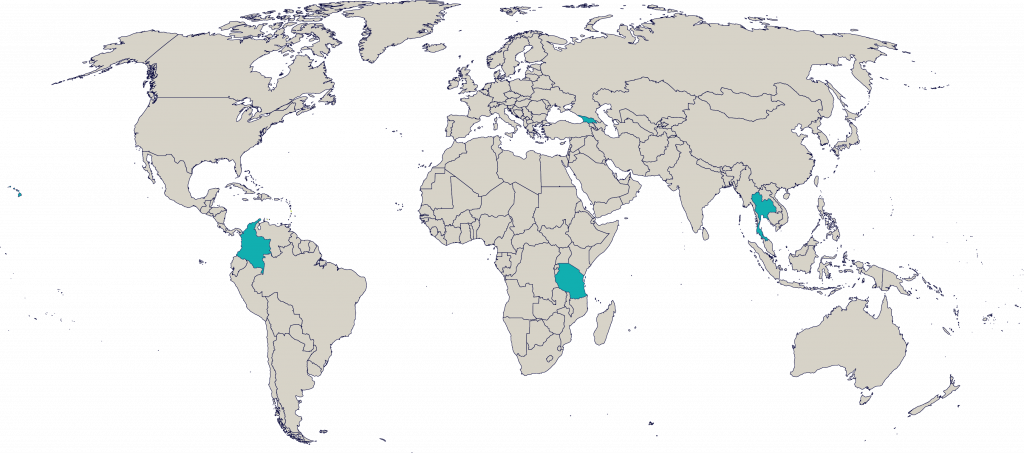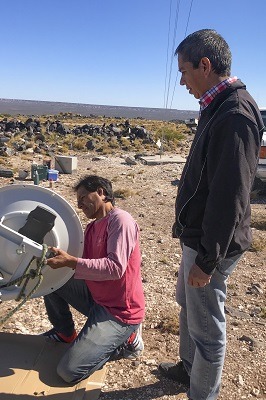Impact Report 2019 > Community Networks
Community Networks
Community networks — networks built, managed, and used by local communities — are cornerstones of the Internet Society’s work.
The Internet is a part of the social, economic, and cultural fabric for billions of people around the globe. It is how they connect, communicate, create, and collaborate. But while the Internet revolution has come to most of the world, there are places that have been missed.
There is a solution for many of these places. Community networks — networks built, managed and used by local communities — are cornerstones of the Internet Society’s work. These do-it-yourself networks are a solution for many remote and rural areas, as well as underserved urban areas where there is a limited business case for traditional Internet service providers. Community networks offer a way for anyone, anywhere, to connect to the Internet with right tools and support.
While the technology — the “network” part of a community network — is important, our experience shows us that the most important part of building a sustainable community network is the human factor – the “community” part of a community network. Sometimes, one of the best roles the Internet Society can play is as a convenor, providing the opportunity for open discussions and helping expand and strengthen the Internet development community.
In 2019, the Internet Society held five regional community network summits. These summits brought together thousands of network operators, regulators and policymakers, development agencies, community members, and other interested stakeholders in person and online to promote the use of community networks, stimulate policy and regulatory change, and increase collaboration between network operators.

But the summits weren’t just about talking. They had concrete, meaningful outcomes.
Indigenous Connectivity Summit in North America
At the Indigenous Connectivity Summit in Hawai’i, participants worked together to develop a set of policy recommendations that will help support the creation of community networks in Indigenous communities in Canada and the United States
European Summit on Community Networks
In the Republic of Georgia, a new community network was brought online as part of the 2019 European Summit on Community Networks. A collaborative effort, this network was the result of the Georgian government, United States Agency for International Development (USAID), the Czech Development Agency, and the Internet Society working together. This deployment drew the interest of both the Internet Society Armenia Chapter and the Government of Armenia, who are now working with us to deploy a network there in 2020, building our global community of local connectivity champions.
Effective policies and legislation, as well as funding, are key to creating an environment that fosters the development of community networks.
In 2019, the Internet Society worked with governments and intergovernmental organizations on a wide variety of connectivity issues, resulting in the following achievements:
- At its Information and Communications Technology ministerial meeting in October 2019, the African Union (AU) adopted a declaration to “Promote the formulation and pilot projects for unlocking basic infrastructure and services for rural and remote areas, including Community Networks,” paving the way for AU member states to review their national policies and regulations to encourage the creation of community networks.
- Discussions at the Community Network Summit in Tanzania, held in partnership with the Association for Progressive Communications, led to increased government support to fund community networks through Universal Service Funding.
- The Arctic Council’s 2019 report, Improving Connectivity in the Arctic, referenced the 2018 Indigenous Connectivity Summit, and includes recommendations that reflect the discussions held there. This report provides the eight Arctic States and Indigenous organizations with a framework for enhancing connectivity in some of the most remote regions in the world.
- In 2019, the Government of Papua New Guinea signed a Memorandum of Understanding (MOU) with the Internet Society to work together to design and deploy a community network in a rural coastal area of the country that local residents will manage. The activities outlined in the MOU include training workshops for community residents to successfully use online services and the development of a case study on the network deployment.
- Furthermore, by the end of 2019, six development agencies and international development banks support community networks or have provided funding from their portfolios: the International Telecommunication Union’s Development Sector, the World Bank, the African Union, the Development Bank of Latin America, the Czech Development Agency, and USAID.
Ensuring communities have access to the skills and knowledge they need to build and operate their own networks is also crucial for access-related initiatives to succeed.
For example, the Internet Society worked with CITEL, the telecommunications commission of the Organization of American States, to deliver the online course Building Wireless Community Networks. More than 150 individuals from across the Americas registered for this training program.

Pu’uhonua o Waimanalo, Community Network
- In 2019, the Internet Society worked with the Nation of Hawai’i, the Hawaiian Chapter, University of Washington, MuralNet, and others to build a community network in the Native Hawaiian community of Pu’uhonua o Waimanolo, Hawai’i.
- Over eight weeks, residents were trained to build, troubleshoot, and manage their own network.
- This new network, owned and operated by the community, now provides high-speed Internet access to all 90 residents.
- Children in the community no longer have to travel outside of their village to complete homework and new opportunities for economic and social development are available to residents.

El Cuy Community Network
- Extreme weather and economic marginalization meant that El Cuy, a village in the Patagonia region of Argentina, was not connected to the Internet.
- In 2019, the Internet Society worked with community members and partners like CABASE and the ENACOM to help El Cuy build and operate a sustainable, self-deployed community network.
- El Cuy’s residents see many benefits of the network, including health, education, and access to information. For example, community members can now access information and certain medical procedures online, instead of traveling more than 100 kilometres to the hospital

2019 Chapterthon
The Internet Society’s 2019 Chapterthon, an annual event in which Internet Society Chapters develop projects to achieve a common goal, focused on access.
Twenty-eight Chapters participated in the 2019 event, themed Connecting the Unconnected. They were challenged with creating innovative solutions to extend Internet access to the unconnected. The winning projects represent a diverse set of innovative and ambitious projects:
- The South African Chapter’s project, Qokolweni Wi-fi Hotspots, provides Internet hotspots for underserved, rural communities. During the 24-hour Chapterthon, the Chapter created a network for the 350 residents of Qokolweni, as well as a checklist for others interested in building community networks.
- The digital divide isn’t limited to rural and remote regions. Many residents of urban areas lack affordable access to the Internet. For this reason, the New York Chapter helped NYC Mesh expand its urban network to six new, previously underserved locations, all within 24 hours.
- In Ghana, the Chapter helped enhance access to information for rural communities in their local language using an FM broadcast system and Raspberry-pi computers. RADIONET provides access to crucial information like weather forecasts for local residents. During the Chapterthon, access to RADIONET was provided to the 200 residents of Ongha, Namibia, which provided enhanced communications for local businesses and opportunities for students.
By participating in the 2019 Chapterthon, these Chapters were able to highlight their work to expand access in their region, and promote new and unique access solutions that can serve as inspiration for projects in other parts of the world.
There is still much more to do to bring the Internet to the 49 per cent of the population who lack access.
In 2020, our focus will be to continue to support local communities to build and operate their own networks, build local capacity, convene stakeholders so that they learn from each other and create the human networks to support local connectivity, and to work with governments to ensure policies and laws support their creation. Together with our partners, Chapters and members, we will ensure everyone, everywhere has access to the Internet of opportunity.
Keep up to date on the Internet Society’s work on community networks, and follow #CommunityNetworks on Twitter!
Get Involved
Join our global movement of people committed to creating a bigger, stronger Internet for everyone.
Members globally
Chapters & SIGs
Organization members
Image copyrights:
Leading image: © Chris Gregory, Waimanalo Community Network: © Elyse Butler, El Cuy Community Network: © Internet Society / Christian O’Flaherty, 2019 Chapterthon: © Elliot Adombila, Internet Society Ghana Chapter